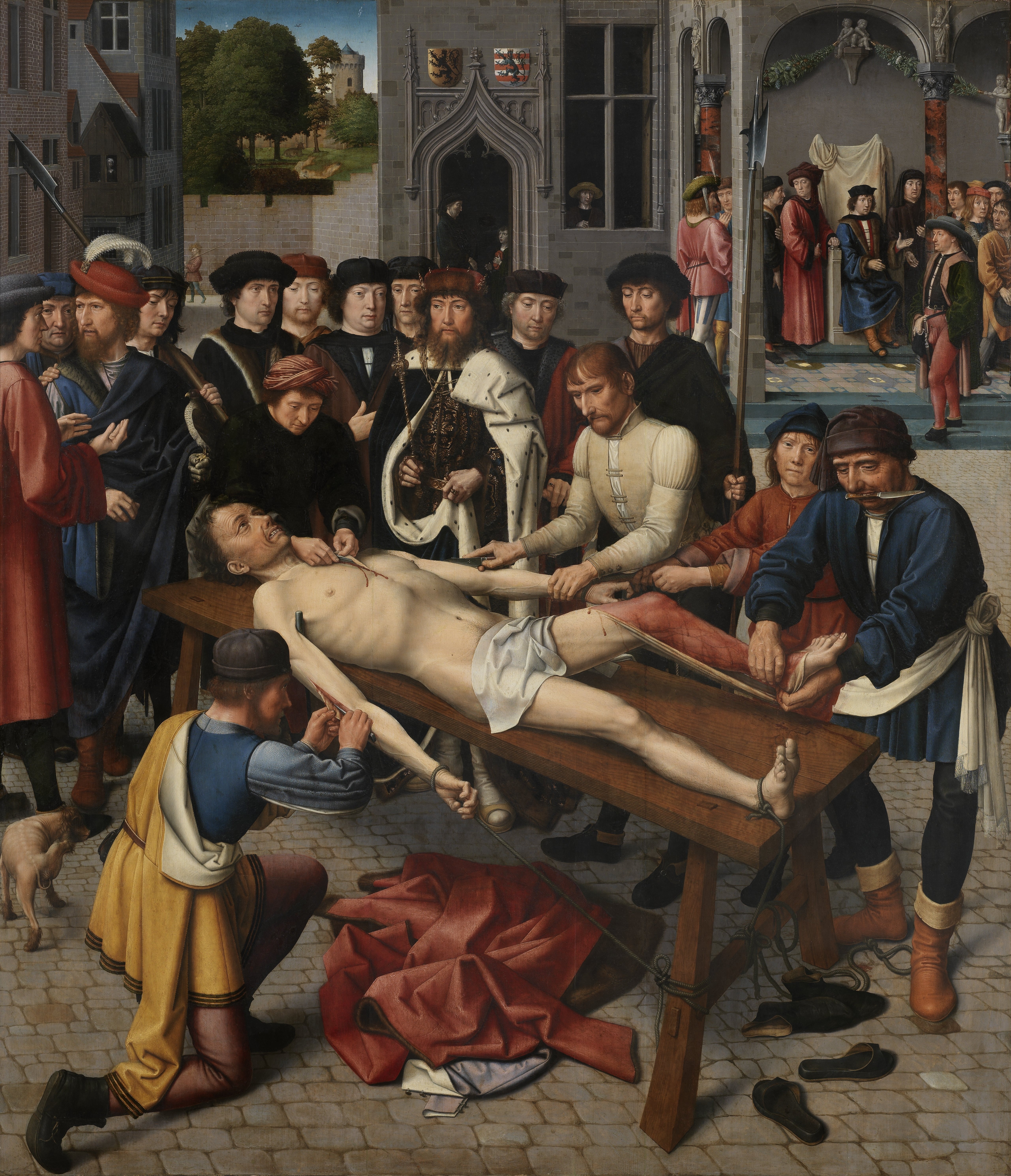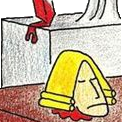
Turkish artist/attorney Cem Koç brilliantly conceived/executed our logo (gratefully used here by his kind permission), Themis and Court (one of two by that title), in 2012. Themis (Θέμις) is the ancient Greek name for the allegorical personification (or “goddess”) of divine order/law/fairness/morality in judicial systems; the Egyptian name for the equivalent concept is Ma’at, and the Roman name is Justicia (medieval corruption of Latin Iūstitia), now translated/rendered in English as Lady Justice.
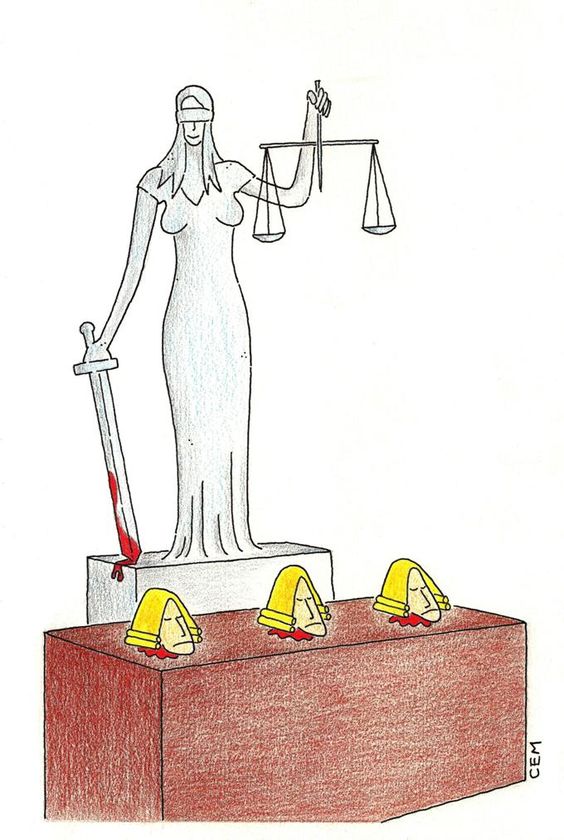
Themis and Court joins other grand traditional works of brave artists who dare depict the just punishment of corrupt judges (the epitome of the genre is The Judgment of Cambyses, discussed infra).
See more of Cem’s fine work at http://justicecartoons.blogspot.com/, http://cemkoccartoon.blogspot.com, https://www.toonpool.com, http://terazininkefesi.blogspot.com, and elsewhere. He can be reached at figencemkoc@gmail.com. To find other Cem works, use the web-search term “Justice Cartoons.”
There are, of course, countless beautiful/artistic sculptural renditions of Lady Justice throughout the world, especially (but not solely) the Western world (see here ⌥ for a sample/typical popular usage). Perhaps the most iconic/exquisite/perfect exemplar being the militaristic (un-blindfolded)α bronze by Johann Hocheisen (1611, subsequently refurbished/reconstructed), standing atop the Gerechtigkeitsbrunnen (Fountain of Justice, 1543) in the old town center, Römerberg (City Hall square) of Frankfurt am Main, Hesse, Germany:
α・ Noting that the blindfold meme only started gaining traction in the sixteenth century, symbolic of rejecting non-objective unfair/corrupting influences — other than the applicable legal rule, judging the case rather than the parties — from such sources as monarch, executive/legislative branches, great wealth/power, their own biases, etc. Procedure is the blindfold of justice.

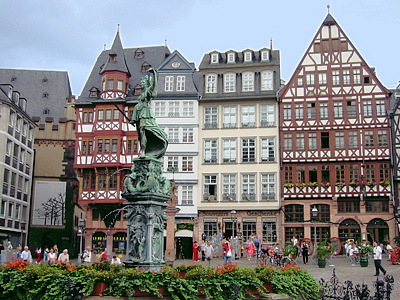


That said, it must be acknowledged that Cem Koç’s rendition of Lady Justice most closely resembles the magnificent elegant specimen (marble, atop a pedestal, indoors, angelic, blindfolded, sculptor unknown, c. 1760), at the base of the grand staircase of the Palazzo Castellania, Valletta, Malta:
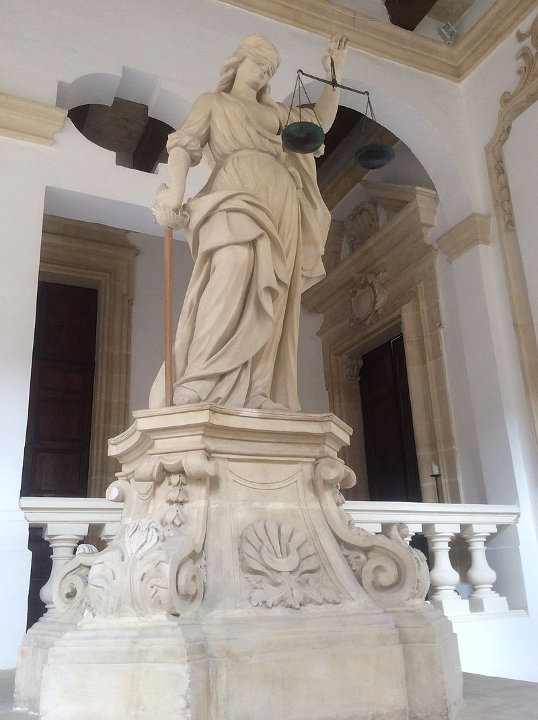
For More Concerning Justice Iconography …
“The usual” general resource is to consult the Internet (web-search for “Lady Justice” and related terms — “follow your nose”). For example: Visual Rhetoric ⌥ ⌥.
A compendium of (pointers to) pictures can be found at Images of Justice (the Goddess) ⌥ ⌥ ⌥.
For the ne plus ultra resource, see the scholarship of Dennis Curtis and Judith Resnick (husband-and-wife team): (i) Images of Justice, 96 Yale Law Journal 1727 (1987) ⌥; and (ii) Representing Justice, the Jayne Lecture (Proceedings of the American Philosophical Society Vol. 151, No. 2 (Jun., 2007), pp. 139-183) ⌥; eventually leading to (iii) the exhibition (now an “online exhibition”) of the Yale Law Library’s Rare Book Collection entitled The Remarkable Run of a Political Icon: Justice as a Sign of the Law (New York Times, Yale University; ⌥) — and finally culminating in (iv) the ultimate book, Representing Justiceβ ⌥ ⌥ (2011) (review1 ⌥; review2 ⌥; review3 ⌥; review4 ⌥; review5 ⌥).
β・ This book discusses, not only Lady Justice images, but also other “Representations” of Justice, such as governmental buildings, especially courthouses (which in turn host the most important images of Lady Justice, of course). Examples ⌥.
Concerning Punishment Of Corrupt Judges
Cem Koç’s Themis and Court portrays not only Lady Justice herself, but also punishment (by beheading) of corrupt judges. That topic is also a classical concern, and is also covered in Chapter 3 (Obedience: The Judge as the Loyal Servant of the State) of the great book Representing Justice cited supra (and in many other places). The finest artistic portrayal of judicial punishment, shown below (credit: Wikimedia Commons, public domain), is the oil-on-wood diptych by the early Dutch artist Gerard David (1460–1563) known as The Judgment of Cambyses (1498), which has already been mentioned supra, originally installed in the Bruges (Belgium) Town Hall’s Judgement Room, now on display at the Groeninge Museum ⌥ ⌥.
The story comes from Herodotus’ Histories (440 BCE), Book 5, Chap. 25. Cambyses II, King of Persia during 530–522 BCE, discovered that Judge Sisamnes was corrupt (he can be seen in the doorway, upper-left of Left Panel below, accepting a bribe, thanks to which he later delivered an unjust verdict). Cambyses arrested Sisamnes (Left Panel), and had him flayed alive (Right Panel). Cambyses then appointed Sisamnes’ son, Otanes, to his father’s vacant Judicial position. And as a gruesome daily reminder to Otanes of his duty to judge honestly, Cambyses had the judicial throne covered with Sisamnes’ skin/leather (this can be seen in the upper-right of Right Panel).

